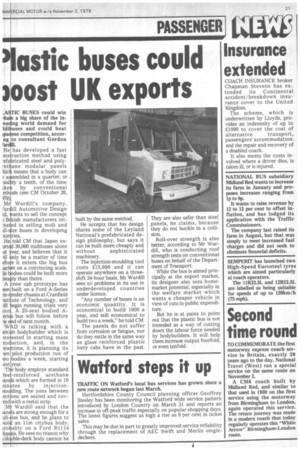%sec buses could
Page 23

If you've noticed an error in this article please click here to report it so we can fix it.
3 ost UK exports IC BUSES could win ri a big share of the inea ng world demand for idi uses and could beat 'pa ese competition, accorng to consultant Gordon He has developed a fast ms ruction method using -efa ricated steel and polyret ane modular panels Mc means that a body can a embled in a quarter, or )ssi ly a tenth, of the time Lke by conventional eth ds (see CM October 26, 179) M Wardill's company, Ian ill Automotive Design td, ants to sell the concept B 'fish manufacturers intres d in selling midi and ze buses in developing )un ies.
He told CM that Japan exort 30,000 midibuses alone st ear, and believes that it nly be a matter of time efo e it enters the big bus iar t on a convincing scale. ies could be built more hea ily than theirs.
A rew cab prototype has een built on a Ford A-Series render chassis at Cranfield 1st' ute of Technology, and rill gin running trials very oo A 25-seat bodied Aeri bus will follow before d of next month.
W D is talking with a riti.h bodybuilder which is te ested in starting mass ro uction, and, in the -tea time, it is planning its wn pilot production run of wo bodies a week, starting ,ext year.
T e body employs standard tee -reinforced urethane en s which are formed in 10 nin tes by injectionnou ding. The joins between ect ons are sealed and coyTed with a metal strip. M Wardill said that the )an Is are strong enough for a ullize bus, and he plans to )uils an llm citybus body, iro ably on a Ford R1114 has is. He sees no reason why ids ble-deck body cannot be built by the same method.
He accepts that his design shares some of the Leyland National's prefabricated design philosophy, but says it can be built more cheaply and without sophisticated machinery.
The injection-moulding tool costs £15,000 and it can operate anywhere on a threeshift 24-hour basis. Mr Wardill sees no problems in its use in underdeveloped countries under licence.
"Any number of buses is an economic quantity. It is economical to build 1000 a year, and still economical to build two a week," he told CM.
The panels do not suffer from corrosion or fatigue, nor do they rattle in the same way as glass reinforced plastic lorry cabs have in the past. They are also safer than steel panels, he claims, because they do not buckle in a collision.
Roll-over strength is also better, according to Mr Wardill, who is conducting roof strength tests on conventional buses on behalf of the Department of Transport.
While the bus is aimed principally at the export market, its designer also sees homemarket potential, especially in the welfare market which wants a cheaper vehicle in view of cuts in public expenditure.
But he is at pains to point out that the plastic bus is not intended as a way of cutting down the labour force needed by bodybuilders. It will help them increase output fourfold, or even tenfold.




























































































































